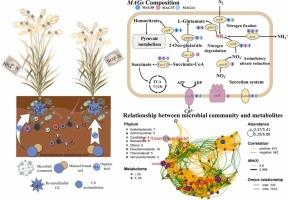宏基因组学和代谢组学的结合揭示了氮肥施用对水稻固定修复镉的再活化和根际微生物演替的影响
IF 11.3
1区 环境科学与生态学
Q1 ENGINEERING, ENVIRONMENTAL
引用次数: 0
摘要
氮肥对污染农田土壤中镉(Cd)的再活化作用引起了人们对固定化修复效果的关注。通过田间试验,研究了施用100 kg/ha的氨氮(NH4+-N)和氮肥(NO3——N)对水稻不同生育期修复性镉(与粘土坡面石结合)再活化和固定化的影响。研究结果表明,NH4+-N诱导水稻根系分泌的有机酸(如苯甲酸和苹果酸)增加,显著提高了nh4no3可提取Cd含量。结果表明,糙米中Cd含量变化范围为39.84 ~ 43.25 μg/kg ~ 78.31 ~ 90.44 μg/kg。NO3—N对Cd的再活化能力相对较弱(糙米Cd含量为50.17 ~ 65.23 μg/kg)。同时,根系中有机酸的分泌抑制了大部分功能基因(如nifK和napA)的表达,导致微生物群落和功能代谢(如Cd2+输出)的变化。根据宏基因组组装基因组(metagenome-assemble genome, MAG)组成分析结果,在NH4+-N处理下,具有较少功能注释的特异性MAG富集,可能通过刺激amt表达进一步增加水稻镉暴露风险。代谢产物与微生物群落的相互作用分析表明,与支链氨基酸(BCAA)代谢和尿素循环相关的酸可能是影响微生物动力学的潜在关键过程。本文章由计算机程序翻译,如有差异,请以英文原文为准。

The combination of metagenomics and metabolomics reveals the effect of nitrogen fertilizer application driving the remobilization of immobilization remediation cadmium and rhizosphere microbial succession in rice
The remobilization of cadmium (Cd) in contaminated farmland soil due to nitrogen fertilizer addition has raised significant concerns regarding the effectiveness of immobilization remediation. This study investigated the effects of ammonia nitrogen (NH4+-N) and nitrogen (NO3--N) application (100 kg/ha) on the remobilization of immobilization of remediation Cd (bound to clay palygorskite) during various growth stages of rice through field experiments. Our findings revealed that increased organic acid secretion (e.g., benzoic acid and malic acid) from rice roots, induced by NH4+-N, significantly enhanced the NH4NO3-extractable Cd content. Consequently, the concentration of Cd in brown rice varied from 39.84 to 43.25 μg/kg to 78.31–90.44 μg/kg. While NO3--N exhibited a relatively weaker capacity for Cd remobilization (Cd content in brown rices: 50.17–65.23 μg/kg). Meanwhile, the organic acid secretion in roots inhibited the expression of most functional genes (e.g., nifK and napA), leading to shifts in microbial communities and functional metabolism (e.g., Cd2+ exporting). According to the results of metagenome-assembled genome (MAG) composition, specific MAGs with fewer functional annotations were enriched under NH4+-N treatment, may further increased risk of Cd exposure in rice by stimulating amt expression. Interaction analysis of metabolic products and microbial communities indicated acids linked to branched-chain amino acid (BCAA) metabolism and urea cycle might serve as a potentially key process influencing microbial dynamics.
求助全文
通过发布文献求助,成功后即可免费获取论文全文。
去求助
来源期刊

Journal of Hazardous Materials
工程技术-工程:环境
CiteScore
25.40
自引率
5.90%
发文量
3059
审稿时长
58 days
期刊介绍:
The Journal of Hazardous Materials serves as a global platform for promoting cutting-edge research in the field of Environmental Science and Engineering. Our publication features a wide range of articles, including full-length research papers, review articles, and perspectives, with the aim of enhancing our understanding of the dangers and risks associated with various materials concerning public health and the environment. It is important to note that the term "environmental contaminants" refers specifically to substances that pose hazardous effects through contamination, while excluding those that do not have such impacts on the environment or human health. Moreover, we emphasize the distinction between wastes and hazardous materials in order to provide further clarity on the scope of the journal. We have a keen interest in exploring specific compounds and microbial agents that have adverse effects on the environment.
 求助内容:
求助内容: 应助结果提醒方式:
应助结果提醒方式:


